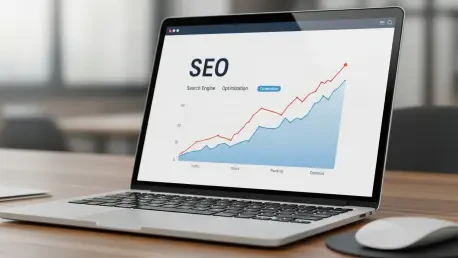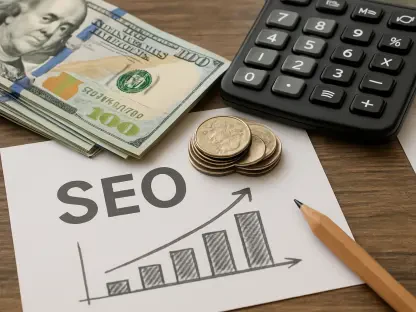Igniting Digital Growth: The SEO Market’s Meteoric Rise
Imagine a digital world where visibility equates to survival, and businesses scramble to secure top spots on search engine results pages, making Search Engine Optimization (SEO) a linchpin for success by driving organic traffic and shaping online presence. Valued at a staggering $72.47 billion in recent estimates, the global SEO market is on a trajectory to reach an astounding $380.2 billion by 2032, propelled by a robust compound annual growth rate (CAGR) of 16.84%. This remarkable forecast underscores the pivotal role SEO plays in modern marketing strategies, as companies across industries pivot toward digital channels to capture consumer attention. What forces are fueling this unprecedented boom, and how can stakeholders position themselves to thrive?
This analysis dives deep into the heart of the SEO market, unraveling current trends, historical shifts, and future projections. It aims to provide a clear lens on the dynamics steering this industry forward, from technological breakthroughs to evolving user behaviors. By dissecting key drivers, challenges, and regional nuances, this examination offers a roadmap for businesses and investors eager to tap into a digital goldmine.
Unpacking the SEO Market: Trends and Trajectories
Historical Context: SEO’s Journey to Prominence
Tracing the roots of SEO reveals a fascinating evolution from a rudimentary practice to an indispensable strategy. In the late 1990s, early search engines operated on basic algorithms, allowing simplistic tactics like keyword stuffing to dominate. Over time, updates from major players like Google transformed the landscape, emphasizing user experience and quality content, which pushed the industry toward sophistication. This shift marked SEO’s transition from a niche tool to a critical component of digital marketing.
Fast forward to the present, and the market reflects a matured ecosystem where technical precision meets creative strategy. The integration of mobile technology and social media has further expanded its scope, making adaptability a cornerstone of success. Understanding this progression highlights why SEO commands such a significant valuation today and sets the stage for exploring the catalysts behind its projected growth to $380.2 billion by 2032.
Current Valuation and Growth Forecast
As of the latest data, the SEO market holds a valuation of $72.47 billion, a testament to its entrenched position in digital ecosystems. Projections indicate a surge to $380.2 billion by 2032, driven by a consistent CAGR of 16.84% from now through the forecast period. This growth trajectory signals robust demand as businesses increasingly prioritize organic search to enhance visibility and engagement in an era dominated by digital interactions.
Such expansion is not merely a number but a reflection of deeper market dynamics. Industries ranging from e-commerce to real estate are investing heavily in SEO to secure competitive edges, recognizing that online presence directly correlates with revenue potential. This financial upswing also opens doors for innovation, as companies race to develop solutions that align with ever-changing search engine criteria.
Technological Catalysts: AI and Beyond
At the forefront of SEO’s growth lies the transformative power of artificial intelligence (AI) and machine learning (ML). These technologies are revolutionizing optimization practices by automating complex tasks like keyword analysis and content personalization. Tools leveraging AI enable businesses to predict trends with precision, drastically reducing manual effort and allowing even smaller entities to compete on a larger scale.
However, the rapid adoption of such technology comes with hurdles. Keeping pace with constant updates requires substantial resources, often straining the budgets of smaller firms. Moreover, an over-reliance on automation risks diluting the human creativity essential for compelling content. Striking a balance between technological efficiency and authentic engagement remains a critical focus for market participants.
Shifting User Behaviors: Mobile and Voice Search Dominance
Another significant driver reshaping the SEO landscape is the pivot toward mobile and voice search. With mobile devices accounting for a majority of web traffic, search engines have prioritized mobile-first indexing, making responsive design a non-negotiable standard. Simultaneously, voice search, powered by virtual assistants, demands a focus on conversational queries, often tied to local intent like “nearby coffee shops.”
Adapting to these trends presents both opportunities and challenges. Crafting content for natural language and ensuring mobile compatibility can yield substantial traffic gains, especially for localized businesses. Yet, the shift necessitates strategic overhauls, and lagging behind competitors in implementation can erode market share. Businesses must weigh investment costs against potential returns in this fast-evolving space.
Regional Variations: A Global Mosaic of SEO Adoption
The SEO market’s growth story unfolds differently across regions, shaped by technological infrastructure and cultural factors. North America leads with advanced digital ecosystems, particularly in the USA, where high adoption rates fuel innovation. Europe follows, with a strong emphasis on localized content and compliance with strict data privacy regulations like GDPR, influencing optimization approaches.
Meanwhile, the Asia-Pacific region emerges as a powerhouse of growth, driven by expanding internet access in countries like India and China, where mobile usage surges. Emerging markets in Latin America and the Middle East offer untapped potential, though challenges like inconsistent connectivity persist. Tailoring strategies to these diverse landscapes—through multilingual content or region-specific campaigns—becomes essential for maximizing impact and avoiding missteps in global outreach.
Future Outlook: Innovations on the Horizon
Peering into the future, several trends promise to redefine the SEO market’s trajectory. Expansion into underserved regions, such as parts of Africa, is gaining traction as companies deploy localized strategies to capture new audiences. Technological advancements, including the Internet of Things (IoT) and blockchain, are set to enhance data security and personalize user experiences, potentially integrating real-time insights into optimization tools.
Economic and regulatory shifts also loom large. Tighter data privacy laws may reshape tracking methodologies, while budget fluctuations could influence digital marketing spending. Additionally, sustainability is emerging as a ranking factor, with search engines potentially favoring eco-conscious brands. Speculatively, AI might evolve to craft entire content ecosystems, though ethical debates around automation’s role in authenticity will likely intensify.
Reflecting on the SEO Surge: Strategic Pathways Forward
Looking back on this deep dive into the SEO market, the journey from a $72.47 billion valuation to a projected $380.2 billion by 2032 underscores a transformative era defined by innovation and adaptation. The analysis revealed how AI, mobile optimization, and regional nuances shaped a dynamic industry, while challenges like algorithm unpredictability demanded resilience. Each facet, from technological drivers to global disparities, painted a picture of an ever-evolving digital frontier.
For businesses and investors, the path ahead involves embracing diversified tactics—blending technical SEO with high-quality content creation. Leveraging AI for efficiency, prioritizing mobile-first design, and focusing on local markets emerge as actionable steps to maintain relevance. Furthermore, staying attuned to regulatory changes and emerging trends like sustainability offers a chance to lead rather than follow. Navigating this landscape with strategic foresight promises not just survival, but a thriving stake in a digital powerhouse.









